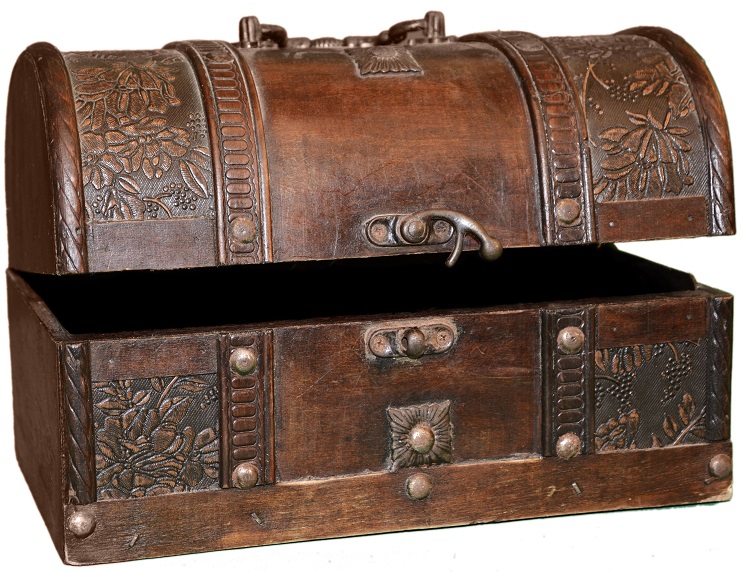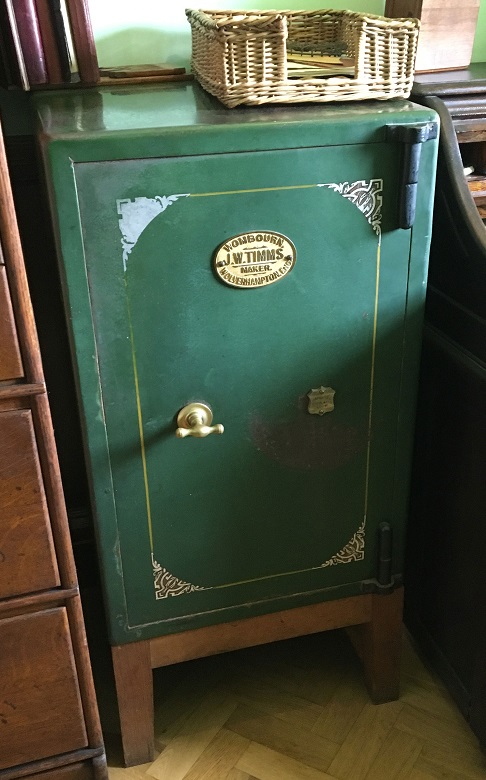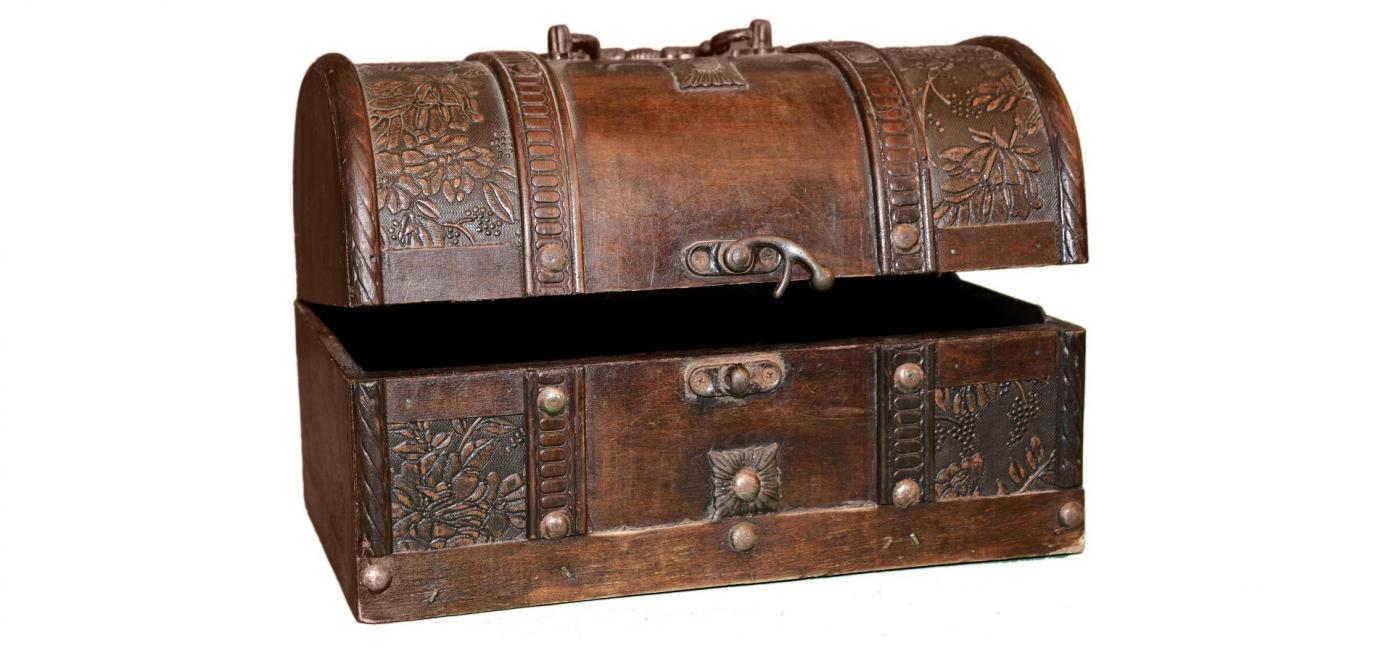The history of safes and secure deposit boxes goes back thousands of years and is inseparably bound up with the needs of individuals to protect their assets.
Since ancient times, there have been groups and individuals who have needed secure storage or protection for their money, jewellery and other valuables.
Protection for the extremely wealthy such as Royals and barons was once provided by private armies and guards, while their dwelling places were often fashioned after the need for defence, as fortified castles or palaces.
However, there were also many more individuals who did not have the luxury of a castle or a private army and had to find alternative ways to protect their valuables at home. As a result, dedicated secure storage facilities were required.
There is evidence that strong wooden boxes tied up with iron hoops were used for this purpose for thousands of years.
Secure Storage in Ancient Greece and Rome
In ancient Greece, temples were often used to store both collective civic treasures and the assets of wealthy individuals.
Money boxes with slits allowing the insertion of coins date back at least to the 2
nd century BCE, the accepted dating of one found by archaeologists in the ancient Greek city of Priene, now a part of Western Turkey.
In ancient Rome, banking activities moved from temples to privately managed buildings, and at length became regulated by the authorities of the Roman Empire.
During the Roman period, combination locks with rotating dials were introduced for security on boxes, as an alternative to keyholes. The earliest known example dated to the period was found in a tomb within the city of Athens, Greece.
Secure Storage in Early Medieval China
Under the Tang Dynasty (618 to 907), when China was the most prosperous country in the world, wealth was often stored in the form of valuable physical commodities held under armed guard in private storage facilities.
The most common commodity used to store wealth at the time was silk. Sometimes, precious metals or minerals such as common salt would be held instead.
Secure Storage in the Middle Ages and Renaissance Europe

Throughout the middle ages and the Renaissance prior to 1700, lockable wooden boxes or chests remained the standard secure storage system. A basic construction of thick, heavy hardwood was the norm; and ornate decorative carvings are sometimes found on the outsides of surviving examples from the 13
th century onwards. The wooden chests were sometimes reinforced for strength with iron bars or bands.
The frequent addition of multiple locking bolts for security added considerably to the weight and to the difficulty of opening and closing medieval safes. Hinged lids were used, but in view of the extremely heavy construction making the lids on larger safes difficult to lift, hinged side-doors were sometimes used instead.
The locks and keys used varied in their complexity according to the security requirements. Hoop-shaped iron fastenings were commonly used for strength, and multiple locking iron bolts were sometimes added for extra security.
Combination locks were in use in the Islamic Middle East, as documented by Al-Jazari in his
Book of Knowledge of Ingenious Mechanical Devices. Other examples of similar origin have been preserved in museums in Copenhagen, Denmark and Boston, USA to this day.
Combination locks were also in use in Renaissance Europe, as described by the 16
th century Italian mathematician Gerolamo Cardano, who is said to have invented his own working model.
Safes in Georgian and Victorian England

In the 18
th century, wrought-iron chests were in use for the secure storage of objects; and by the end of the century, chests made of cast iron had been introduced by manufacturers in Coalbrookdale (near Ironbridge, near what is now Telford) and Scotland, and were the closest thing available to a modern safe, but they did not offer significant fire resistance.
Banks did not yet have vaults as we know them today, but made use of secure rooms.
In the 19
th century, burglars were often equipped with crowbars to force open locks, and they sometimes even used gunpowder to blow up the locks on safes, so the need for enhanced security measures developed in response to their tools and techniques.
A patent was filed in 1835 by the Chubb brothers of Wolverhampton, England, for a burglar-resistant safe for private storage. By 1837, they had started up a factory in London dedicated to the manufacturer of safes. By 1851, they had also branched out into the production of secure display cases for valuable jewellery.
The Chubb brothers had begun producing locks since 1818, and such was their success that Chubb continued as an independent company until 1984. Chubb keys and locks will be familiar to almost anyone in the UK in the twentieth century; and the Chubb brand remains active today.
By the mid-19
th century safes were being fashioned from dual metal layers, each typically comprising a mixture of tinplate and sheet iron. An inner layer of mixed hardwood, sawdust and alum offered some fire protection to the contents in the event of a fire, as molten alum inhibits heat conduction.
Safes in the Early Modern United States
In the 1820s, New York-based inventor Jesse Delano is said to have devised a new method of safe construction for enhanced fire protection. This was based partly on the soaking of the inner wooden framework in a solution of alum and potassium hydroxide, and partly on surrounding the wood with a coating comprising a mixture of clay, lime, graphite and mica.
By the mid-1830s, massively heavy fire-retardant wrought iron safes were being advertised by C. J. Gayler of New York City. These were available in a wide range of sizes suitable for use by customers of different needs, from merchants to records offices and banks. Fire-resistant safes were in common use by the 1840s; and from the 1830s onwards, numerous patents were filed in the United States for ‘improvement in fire-proof safes’.
In 1866 and 1867, American locksmith Linus Yale Jr., who together with his father Linus Yale Sr. bears responsibility for the Yale brand of locks that is one of the most familiar in the world to this day, filed US patents
52,484 and
71,110 for burglar-proof safes.
Development of Rotary Combination Locks
More advanced combination locks have become a common feature on safes since the 19
th century and are considered relatively safe because they cannot be ‘picked’ and it is statistically extremely unlikely that anyone would correctly guess the combination given enough digits.
The modern-style rotary combination locks widely used on safes and bank vaults today deploy a single large dial that must be rotated in different directions according to a pre-set combination in order to open the lock.
This type of lock is much more secure than the simple multi-dial locks used in briefcases and on cheap padlocks, which can potentially be cracked by listening for a slight difference in sound from the mechanism when the right number is selected, or simply by trying every combination in turn when there are only three or four dials.
The rotary combination lock (or permutation lock, as it was more commonly called at the time) underwent significant development in the United States from the 1830s to the 1900s, with many patents for new and improved combination lock designs being successively filed by many American inventors from the 1830s to the 1860s alone
[i]. The fierce commercial competition among these inventors appears to reflect a climate of heightened commercial and public demand for high-security safes in the USA as the century developed.
Joseph Loch of Germany is credited with having made numerous further improvements over the following decades from the 1870s through to the 1900s.
Modern Steel Safes and Bank Vaults

The development of modern steel, with its inherent strength, led to
stronger and more durable safes and the eventual development of bank vaults protected by reinforced steel doors that we know today.
In the early 20
th century, modern concrete was also developed and became a material of choice for strengthening the doors of bank vaults. It has also become common to embed personal and business safes in walls or in or on the floor, with a concrete base providing secure fixing or additional weight that makes it impractical to move them without large equipment.
However, even steel and concrete came under attack from the diamond-tipped drills developed in the 20
th century. To resist such attacks, additional extremely tough ingredients have been added to modern safes, such as a naturally occurring crystalline form of aluminium oxide called corundum, whose hardness on the Mohs scale of 9 is close enough to that of diamond itself (10) to offer protection from drilling.
[i] Notable examples whose original patent documentation makes for fascinating historical reading material include Robert Newell (
Patent No. 944, 1838); J.B. Gray (
Patent No. 2261, September 1841), Sabin Colton (
Patent No. 3395, 1844), M.R. Stephenson and O. Edwards (
Patent No. 3543, 1844), Darius W. Maples (
Pat. No. 3842, 1844), J. H. Butterworth (
Pat. No. 4452, 1846), J. E. Treat (
Pat. No. 93501, 1869) and Linus Yale Jr. (
Pat. No. 82192, 1868; and
Pat. No. 98536, 1870).
 Throughout the middle ages and the Renaissance prior to 1700, lockable wooden boxes or chests remained the standard secure storage system. A basic construction of thick, heavy hardwood was the norm; and ornate decorative carvings are sometimes found on the outsides of surviving examples from the 13th century onwards. The wooden chests were sometimes reinforced for strength with iron bars or bands.
The frequent addition of multiple locking bolts for security added considerably to the weight and to the difficulty of opening and closing medieval safes. Hinged lids were used, but in view of the extremely heavy construction making the lids on larger safes difficult to lift, hinged side-doors were sometimes used instead.
The locks and keys used varied in their complexity according to the security requirements. Hoop-shaped iron fastenings were commonly used for strength, and multiple locking iron bolts were sometimes added for extra security.
Combination locks were in use in the Islamic Middle East, as documented by Al-Jazari in his Book of Knowledge of Ingenious Mechanical Devices. Other examples of similar origin have been preserved in museums in Copenhagen, Denmark and Boston, USA to this day.
Combination locks were also in use in Renaissance Europe, as described by the 16th century Italian mathematician Gerolamo Cardano, who is said to have invented his own working model.
Throughout the middle ages and the Renaissance prior to 1700, lockable wooden boxes or chests remained the standard secure storage system. A basic construction of thick, heavy hardwood was the norm; and ornate decorative carvings are sometimes found on the outsides of surviving examples from the 13th century onwards. The wooden chests were sometimes reinforced for strength with iron bars or bands.
The frequent addition of multiple locking bolts for security added considerably to the weight and to the difficulty of opening and closing medieval safes. Hinged lids were used, but in view of the extremely heavy construction making the lids on larger safes difficult to lift, hinged side-doors were sometimes used instead.
The locks and keys used varied in their complexity according to the security requirements. Hoop-shaped iron fastenings were commonly used for strength, and multiple locking iron bolts were sometimes added for extra security.
Combination locks were in use in the Islamic Middle East, as documented by Al-Jazari in his Book of Knowledge of Ingenious Mechanical Devices. Other examples of similar origin have been preserved in museums in Copenhagen, Denmark and Boston, USA to this day.
Combination locks were also in use in Renaissance Europe, as described by the 16th century Italian mathematician Gerolamo Cardano, who is said to have invented his own working model.
 In the 18th century, wrought-iron chests were in use for the secure storage of objects; and by the end of the century, chests made of cast iron had been introduced by manufacturers in Coalbrookdale (near Ironbridge, near what is now Telford) and Scotland, and were the closest thing available to a modern safe, but they did not offer significant fire resistance.
Banks did not yet have vaults as we know them today, but made use of secure rooms.
In the 19th century, burglars were often equipped with crowbars to force open locks, and they sometimes even used gunpowder to blow up the locks on safes, so the need for enhanced security measures developed in response to their tools and techniques.
A patent was filed in 1835 by the Chubb brothers of Wolverhampton, England, for a burglar-resistant safe for private storage. By 1837, they had started up a factory in London dedicated to the manufacturer of safes. By 1851, they had also branched out into the production of secure display cases for valuable jewellery.
The Chubb brothers had begun producing locks since 1818, and such was their success that Chubb continued as an independent company until 1984. Chubb keys and locks will be familiar to almost anyone in the UK in the twentieth century; and the Chubb brand remains active today.
By the mid-19th century safes were being fashioned from dual metal layers, each typically comprising a mixture of tinplate and sheet iron. An inner layer of mixed hardwood, sawdust and alum offered some fire protection to the contents in the event of a fire, as molten alum inhibits heat conduction.
In the 18th century, wrought-iron chests were in use for the secure storage of objects; and by the end of the century, chests made of cast iron had been introduced by manufacturers in Coalbrookdale (near Ironbridge, near what is now Telford) and Scotland, and were the closest thing available to a modern safe, but they did not offer significant fire resistance.
Banks did not yet have vaults as we know them today, but made use of secure rooms.
In the 19th century, burglars were often equipped with crowbars to force open locks, and they sometimes even used gunpowder to blow up the locks on safes, so the need for enhanced security measures developed in response to their tools and techniques.
A patent was filed in 1835 by the Chubb brothers of Wolverhampton, England, for a burglar-resistant safe for private storage. By 1837, they had started up a factory in London dedicated to the manufacturer of safes. By 1851, they had also branched out into the production of secure display cases for valuable jewellery.
The Chubb brothers had begun producing locks since 1818, and such was their success that Chubb continued as an independent company until 1984. Chubb keys and locks will be familiar to almost anyone in the UK in the twentieth century; and the Chubb brand remains active today.
By the mid-19th century safes were being fashioned from dual metal layers, each typically comprising a mixture of tinplate and sheet iron. An inner layer of mixed hardwood, sawdust and alum offered some fire protection to the contents in the event of a fire, as molten alum inhibits heat conduction.
 The development of modern steel, with its inherent strength, led to stronger and more durable safes and the eventual development of bank vaults protected by reinforced steel doors that we know today.
In the early 20th century, modern concrete was also developed and became a material of choice for strengthening the doors of bank vaults. It has also become common to embed personal and business safes in walls or in or on the floor, with a concrete base providing secure fixing or additional weight that makes it impractical to move them without large equipment.
However, even steel and concrete came under attack from the diamond-tipped drills developed in the 20th century. To resist such attacks, additional extremely tough ingredients have been added to modern safes, such as a naturally occurring crystalline form of aluminium oxide called corundum, whose hardness on the Mohs scale of 9 is close enough to that of diamond itself (10) to offer protection from drilling.
[i] Notable examples whose original patent documentation makes for fascinating historical reading material include Robert Newell (Patent No. 944, 1838); J.B. Gray (Patent No. 2261, September 1841), Sabin Colton (Patent No. 3395, 1844), M.R. Stephenson and O. Edwards (Patent No. 3543, 1844), Darius W. Maples (Pat. No. 3842, 1844), J. H. Butterworth (Pat. No. 4452, 1846), J. E. Treat (Pat. No. 93501, 1869) and Linus Yale Jr. (Pat. No. 82192, 1868; and Pat. No. 98536, 1870).
The development of modern steel, with its inherent strength, led to stronger and more durable safes and the eventual development of bank vaults protected by reinforced steel doors that we know today.
In the early 20th century, modern concrete was also developed and became a material of choice for strengthening the doors of bank vaults. It has also become common to embed personal and business safes in walls or in or on the floor, with a concrete base providing secure fixing or additional weight that makes it impractical to move them without large equipment.
However, even steel and concrete came under attack from the diamond-tipped drills developed in the 20th century. To resist such attacks, additional extremely tough ingredients have been added to modern safes, such as a naturally occurring crystalline form of aluminium oxide called corundum, whose hardness on the Mohs scale of 9 is close enough to that of diamond itself (10) to offer protection from drilling.
[i] Notable examples whose original patent documentation makes for fascinating historical reading material include Robert Newell (Patent No. 944, 1838); J.B. Gray (Patent No. 2261, September 1841), Sabin Colton (Patent No. 3395, 1844), M.R. Stephenson and O. Edwards (Patent No. 3543, 1844), Darius W. Maples (Pat. No. 3842, 1844), J. H. Butterworth (Pat. No. 4452, 1846), J. E. Treat (Pat. No. 93501, 1869) and Linus Yale Jr. (Pat. No. 82192, 1868; and Pat. No. 98536, 1870).



